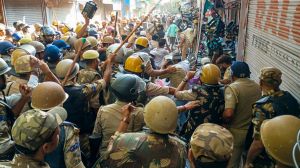When the dead come to life
This is in response to S.C. Parmar's appeal to restore the former glory of Prithviraj Chauhan (Write Back, January 19), a man made into a ...

This is in response to S.C. Parmar’s appeal to restore the former glory of Prithviraj Chauhan (Write Back, January 19), a man made into a myth more by the kind passage of history, than by the actual circumstances of his reign. Accounts of his reign are borne out mainly by Chand Bardai’s Prithviraj-raso, a work that has gone through several versions; the version most current is a much later composition.
Prithviraj, it is true, did lead the Rajputs in the battle of Tarain, where he was defeated and killed. Muhammed Ghori was assassinated later, in 1206, by political rivals in Afghanistan and not, as the story goes, by a blinded Prithviraj who, guided by Ghori’s voice, aimed and killed Ghori with his arrow. Parmar also cites Colonel Tod’s Annals and Antiquities of Rajasthan as the only source of some authority on the history of the Rajputs. Tod’s work is more rooted in myth — citing the rise of the four main Rajput families as having descended from a mythical figure who arose from the sacrificial fire near Mount Abu. Tod’s work is helpful for its collation of early myths and tales but other contemporary work in translation also exist today, that throw light on this period (Kathasaritasagar, Vikramankadevacharita, Karpuramanjari, as well as works by Arab writers like Alberuni).
A balanced reading of all these works would help us see Prithviraj in a truer perspective. Rulers of the time desired to rule over Bharata and gave themselves fancy titles. Prithviraj was no exception — ruling over Delhi and Ajmer, and he titled himself Bharatesvara — the lord of Bharata. His opposition to Muhammed Ghori was guided by economic reasons as well — for Muhammed Ghori desired to conquer and rule over the fertile regions of the Indus and the Punjab. Strangely, the demand for the restoration of Prithviraj’s remains has very recent origins.
In September last year, the Samrat Prithviraj Chauhan Foundation urged the government to bring back the mortal remains of Prithviraj from Afghanistan. In October, the foundation organised a three-day Rashtriya Gaurav Raksha Mahayagya at Neemrana in Rajasthan, where the surviving descendants of the Chauhan family now stay. It was the visit of the former prime minister, Chandrashekhar, among others, to Neemrana, that fuelled the controversy and led to increased demands for restoring Neemrana to its rightful heirs.
The palace (built in the mid-15th century, 400 years after Prithviraj) was sold by later descendants and is now a popular tourist hotel. It retains its unique charm thanks to careful and painstaking restoration work by Aman Singh and Francis Warcziag.
But then using the dead to play out astute games of political manipulation is nothing new. Controversy still rages whether Subhash Chandra Bose, actually died in the air crash as he flew to Japan. The dead have been used by the living to perpetrate their own interests or to resurrect themselves — politically. When Soviet Union became Russia, the removal of Stalin’s body from the Red Square was almost symbolic of the change, as was the exhumation of the Romanovs and their ceremonious reburial in consonance with all religious tradition.
A more celebrated case in point is that of Eva Peron, first lady of Argentina (1946-52), whose remains travelled around three countries, as opponents and supporters fought for her legacy or to discredit her. Evita came to power primarily because of the mass support from the working classes, yet the extravagant lifestyle and shortsighted economic policies of the Perons later plunged Argentina into chaos.
After her death, however, Evita’s working-class followers tried unsuccessfully to have her canonised, but her political opponents, in an effort to exorcise her as a national symbol of Peronism, stole her body in 1955 after Juan Per¢n was overthrown and secreted it in Italy for 16 years. In 1971, Argentina’s military government, turned over her remains to Peron, then a widower in Madrid.
After Juan Peron died in office in 1974, his third wife, Isabel Peron, hoping to gain favour among the populace, repatriated the remains and installed them next to the deceased leader in a crypt in the presidential palace. Two years later a new military junta hostile to Peronism removed the bodies.







- 01
- 02
- 03
- 04
- 05
























